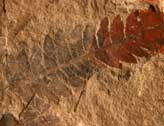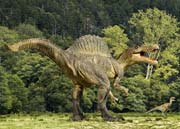
What are Fossils?
 Fossils are the preserved remains of organisms from a long time ago.
Fossils are the preserved remains of organisms from a long time ago.
Hard parts of animals, like bones and teeth, are the most common things that turn into fossils. Fossils can also be in the shape of something that has been left behind by an animal, like a footprint or a burrow – a hole that an animal dug in the ground to live in.
Some fossils are the remains of animals that lived long ago and are now extinct, like dinosaurs. Although there are no dinosaurs alive now, we know they existed because of fossils that have been found all over the world.
There are many different kinds of fossils, and the scientists that study them are called paleontologists (PAY-lee-un-TAL-uh-jests).
What Makes Fossils?
A fossil is formed when a plant or animal gets buried very quickly in wet dirt and sand. When animals or plants are under many layers, their bodies are protected from things that would normally break down their bodies or eat them, like other animals and bacteria. Being trapped in all those layers of mud preserves the plant or animal.
This happens most easily during a natural catastrophe like a flood, mud slide, or earthquake. The hard parts of animals (such as bones, teeth, and shells) that get trapped in these layers of mud are slowly replaced with minerals from the mud, which turn them into a hard material, very similar to rock. A fossil is formed in the same shape as the hard part of the animal, like a tooth or bone.
The soft parts of plants or animals, such as the scales of a fish or the leaves of a plant, sometimes leave a little bit of color in the rock before they eventually break down into nothing. Soft things that turn into fossils usually leave an imprint of their shape as they slowly break down, so it is pressed into the rock instead of being raised up like fossils from hard things are.
Where Are Fossils Found?
Some fossils have to be dug up from the ground and some are visible in rocks. Fossils are most commonly found in soft rocks like limestone, shale, and sandstone. Those rocks get worn down by water and wind more easily than most rocks do. Sometimes larger rocks have layers of fossils inside of them and as the rock gradually wears away over many years, the fossils become visible. Fossils have been found all around the world – on every continent, even Antarctica!
All About Dinosaurs
Dinosaurs are animals that lived a long time ago. They are extinct now, which means that as far as we know, all of them have died. Dinosaurs were reptiles, like lizards and turtles. However, most dinosaurs were very large, the biggest ones were bigger than the largest reptiles that are alive today. Most dinosaurs hatched from eggs.
 There are lots of pictures of dinosaurs and even complete dinosaur skeletons on display in museums. Since dinosaurs are extinct, no one has ever seen a living one. That means the pictures you see of dinosaurs are estimates, even guesses, of what they looked like.
There are lots of pictures of dinosaurs and even complete dinosaur skeletons on display in museums. Since dinosaurs are extinct, no one has ever seen a living one. That means the pictures you see of dinosaurs are estimates, even guesses, of what they looked like.
When fossilized dinosaur bones are discovered, they have to be put together like a puzzle. Some of the bones might be missing and some might be broken into pieces. Sometimes the bones that are found in one spot are from several different animals! All of those things make it very difficult for scientists to figure out what dinosaurs really looked like, so even full skeletons that are on display in museums are just scientists’ best guesses of what the animals might have looked like. The picture to the right is an example of a drawing of what scientists think two types of dinosaurs looked like, based on bones that have been discovered and pieced together.
Scientists have discovered many species of dinosaurs over the years and even more are being discovered as more fossils are found. As more and more fossils are found, what scientists believe about dinosaurs may change.
When Did Dinosaurs Live?
Since scientists only have bones to guess by, it is impossible to say exactly when dinosaurs lived. There are several ideas, but it is hard to find scientific evidence to prove them. A lot of people think dinosaurs lived millions and millions of years ago. Scientists who believe in Creation believe dinosaurs were on the earth at the same time as man, which is thousands of years ago (instead of millions). It is hard to tell exactly what the earth was like back then, with only fossils to go by.
What Did Dinosaurs Eat?
Most dinosaurs ate plants. Even though they were so huge, Sauropods like Brachiosaurus lived on green grass and shrubs. Scientists know this from looking at their teeth that have been found in fossils. Some dinosaurs ate meat. One of the most famous dinosaurs, Tyrannosaurus Rex, was a meat-eater and had sharp teeth and claws to help him get his food. Animals that eat plants are called herbivores. Animals that eat meat are called carnivores.
Science Words
Extinct– when a species of animal that once lived on earth has all died and no longer exists.
Herbivore– an animal that eats plants.
Carnivore– an animal that eats meat.
Printable Worksheet & PDF
Use this worksheet to help kids visualize how huge most dinosaurs were compared to a human and other animals. Discuss that there is a lot of variety in animal life. This is also a great time to review what different animals eat and how they live. Ask kids to describe how they think an animal’s size affects its ability to eat and protect itself. Help them number the pictures on the page in order from largest to smallest.
You can also find printable coloring pages of different dinosaurs at the end of this page and dozens of online coloring pages here.
Click here for dinosaur and fossil science activity ideas.






